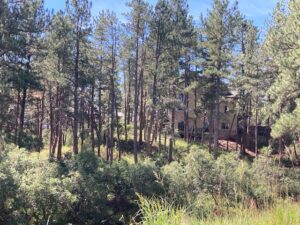Tree Thinning for Forest Management
Tree thinning for forest management. (719)400-9104.
Part of the forest management process is thinning out some of the forests. This usually happens in Zone 2 and beyond. However, if you have questionable trees in Zone 1, you’ll want to get rid of them, too.
Getting the right trees for thinning is important. Some are going to be great for slowing down and preventing the spread of fires, while others are fuel for the wildfires. If you pick the wrong ones, you could put your home and the overall forest in more danger.
Remove the Light-Starved Trees
Look around the land at the way the trees look. If you find any that are scrawny and struggling to get to a light source, you’ll want to remove them. Even if you remove a few trees around these small ones, they’re unlikely to thrive. All you’re doing is creating fuel for fire and food for pests.
You’ll then want to look at the trees that have been snow-bent. The ones that are more than 3in in diameter won’t repair naturally. You won’t even be able to help them repair with sticks. All they do is create ladder fuel for the fires.
Remove Sections Around the Tree Instead
That being said, you won’t want to remove everything that is bent or oddly shaped. Character trees are beautiful additions to the forests. As long as you’re willing to prune them and they look otherwise healthy, keep ones that are a little crooked or have two trunks.
You’ll hear a lot about how dead trees and fallen logs need to be removed immediately. In Zone 3, that isn’t always the case. Some of these trees are homes for animals. They also offer nutrients for woodpeckers. So, you’ll want to keep some of them.
The important thing is to remove a section around the tree. This helps to preserve the homes for wildlife without creating more fuel for fires.
Always Look Up
Picking trees is important, and not just to manage the ladder fuel. You’ll need to look up at the canopies. A lot of fires will spread over the top once they reach there, so you want to create a break between the canopies where possible.
You may think one tree is perfect, but when you look up, the tree next to it has the larger canopy. Removing that one could create more light for the forest floor, helping the smaller trees and reducing the risk of canopy fires.
It’s important to have a mixture of trees. Sure, you want the 100-year-old oak to stand, but you’ll need to allow new life in the forest. You’ll also want a variety of species as they are necessary for the different types of animals in the forests.
Take your time thinning trees. Pick a few now. In three to five years, have another look to see if you need to do more to avoid over thinning the forest. If you need to thin a large section of trees, give us a call at (719)400-9104.We have experience in removing trees for fire mitigation purposes.

